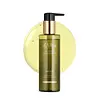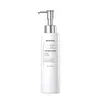What's inside
What's inside
 Key Ingredients
Key Ingredients

 Benefits
Benefits

 Concerns
Concerns

 Ingredients Side-by-side
Ingredients Side-by-side

Water
Skin ConditioningGlycerin
HumectantDisodium Cocoamphodiacetate
CleansingCoco-Glucoside
CleansingLauryl Glucoside
CleansingSodium Chloride
MaskingTea-Cocoyl Glutamate
CleansingTuber Magnatum Extract
Skin ConditioningCentella Asiatica Extract
CleansingMadecassoside
AntioxidantAsiaticoside
AntioxidantAsiatic Acid
Skin ConditioningAcrylates/C10-30 Alkyl Acrylate Crosspolymer
Emulsion StabilisingCitric Acid
BufferingChlorphenesin
AntimicrobialMelaleuca Alternifolia Leaf Extract
PerfumingEthylhexylglycerin
Skin ConditioningXanthan Gum
EmulsifyingButylene Glycol
HumectantCarica Papaya Fruit Extract
Skin ConditioningPyrus Malus Fruit Extract
Skin ConditioningPrunus Mume Fruit Extract
HumectantVitis Vinifera Fruit Extract
Skin ConditioningPanthenol
Skin ConditioningMelia Azadirachta Leaf Extract
Skin ConditioningSaccharide Isomerate
Humectant1,2-Hexanediol
Skin ConditioningMelia Azadirachta Flower Extract
Skin ConditioningCaramel
Cosmetic ColorantCeramide NP
Skin ConditioningMyristic Acid
CleansingStearic Acid
CleansingSodium Citrate
BufferingPalmitic Acid
EmollientArachidic Acid
CleansingLauric Acid
CleansingOleic Acid
EmollientLavandula Angustifolia Oil
MaskingLinalool
PerfumingWater, Glycerin, Disodium Cocoamphodiacetate, Coco-Glucoside, Lauryl Glucoside, Sodium Chloride, Tea-Cocoyl Glutamate, Tuber Magnatum Extract, Centella Asiatica Extract, Madecassoside, Asiaticoside, Asiatic Acid, Acrylates/C10-30 Alkyl Acrylate Crosspolymer, Citric Acid, Chlorphenesin, Melaleuca Alternifolia Leaf Extract, Ethylhexylglycerin, Xanthan Gum, Butylene Glycol, Carica Papaya Fruit Extract, Pyrus Malus Fruit Extract, Prunus Mume Fruit Extract, Vitis Vinifera Fruit Extract, Panthenol, Melia Azadirachta Leaf Extract, Saccharide Isomerate, 1,2-Hexanediol, Melia Azadirachta Flower Extract, Caramel, Ceramide NP, Myristic Acid, Stearic Acid, Sodium Citrate, Palmitic Acid, Arachidic Acid, Lauric Acid, Oleic Acid, Lavandula Angustifolia Oil, Linalool
Water
Skin ConditioningPotassium Cocoyl Glycinate
Polyglycerin-10
HumectantGlycerin
HumectantTea-Cocoyl Glutamate
CleansingSodium PCA
HumectantLauryl Hydroxysultaine
CleansingTuber Magnatum Extract
Skin ConditioningSodium Lauryl Glycol Carboxylate
CleansingArginine
Masking1,2-Hexanediol
Skin ConditioningHydroxyacetophenone
AntioxidantSodium Chloride
MaskingHydroxypropyl Methylcellulose
Emulsion StabilisingHyaluronic Acid
HumectantCeramide EOP
Skin ConditioningCeramide Ns
Skin ConditioningCeramide NP
Skin ConditioningCeramide As
Skin ConditioningCeramide AP
Skin ConditioningDisodium Cocoamphodiacetate
CleansingCentella Asiatica Extract
CleansingDisodium Cocoyl Glutamate
CleansingSodium Taurine Cocoyl Methyltaurate
CleansingXylitylglucoside
HumectantAnhydroxylitol
HumectantGlyceryl Oleate
EmollientSorbitan Caprylate
EmulsifyingPPG-26-Buteth-26
Skin ConditioningTetrasodium Glutamate Diacetate
PEG-40 Hydrogenated Castor Oil
EmulsifyingPotassium Chloride
Xylitol
HumectantHexylene Glycol
EmulsifyingSericin
Skin ConditioningCaprylhydroxamic Acid
Tetrasodium EDTA
Hamamelis Virginiana Water
AstringentParfum
MaskingPortulaca Oleracea Extract
Skin ConditioningButylene Glycol
HumectantEthylhexylglycerin
Skin ConditioningLaminaria Digitata Extract
Skin ProtectingHydrogenated Lecithin
EmulsifyingPhenoxyethanol
PreservativeCholesterol
EmollientCetyl-Pg Hydroxyethyl Palmitamide
Skin ConditioningWater, Potassium Cocoyl Glycinate, Polyglycerin-10, Glycerin, Tea-Cocoyl Glutamate, Sodium PCA, Lauryl Hydroxysultaine, Tuber Magnatum Extract, Sodium Lauryl Glycol Carboxylate, Arginine, 1,2-Hexanediol, Hydroxyacetophenone, Sodium Chloride, Hydroxypropyl Methylcellulose, Hyaluronic Acid, Ceramide EOP, Ceramide Ns, Ceramide NP, Ceramide As, Ceramide AP, Disodium Cocoamphodiacetate, Centella Asiatica Extract, Disodium Cocoyl Glutamate, Sodium Taurine Cocoyl Methyltaurate, Xylitylglucoside, Anhydroxylitol, Glyceryl Oleate, Sorbitan Caprylate, PPG-26-Buteth-26, Tetrasodium Glutamate Diacetate, PEG-40 Hydrogenated Castor Oil, Potassium Chloride, Xylitol, Hexylene Glycol, Sericin, Caprylhydroxamic Acid, Tetrasodium EDTA, Hamamelis Virginiana Water, Parfum, Portulaca Oleracea Extract, Butylene Glycol, Ethylhexylglycerin, Laminaria Digitata Extract, Hydrogenated Lecithin, Phenoxyethanol, Cholesterol, Cetyl-Pg Hydroxyethyl Palmitamide
 Reviews
Reviews

Ingredients Explained
These ingredients are found in both products.
Ingredients higher up in an ingredient list are typically present in a larger amount.
1,2-Hexanediol is a synthetic liquid and another multi-functional powerhouse.
It is a:
- Humectant, drawing moisture into the skin
- Emollient, helping to soften skin
- Solvent, dispersing and stabilizing formulas
- Preservative booster, enhancing the antimicrobial activity of other preservatives
Butylene Glycol (or BG) is used within cosmetic products for a few different reasons:
Overall, Butylene Glycol is a safe and well-rounded ingredient that works well with other ingredients.
Though this ingredient works well with most skin types, some people with sensitive skin may experience a reaction such as allergic rashes, closed comedones, or itchiness.
Learn more about Butylene GlycolCentella Asiatica Extract (Centella) is derived from an herb native to Southeast Asia. It is famous for its anti-inflammatory and soothing properties.
Centella is rich in antioxidants and amino acids, such as Madecassic Acid and Asiaticoside.
Studies show the compounds in centella help with:
The combination of all these properties makes centella effective at soothing, hydrating, and protecting the skin.
Other great components of centella include Vitamin A, vitamin C, several B vitamins, and Asiatic Acid.
Fun fact: Centella has been used as a medicine and in food for many centuries. As a medicine, it is used to treat burns, scratches, and wounds.
Learn more about Centella Asiatica ExtractCeramide NP is a type of ceramide.
Ceramides are intercellular lipids naturally found in our skin that bonds dead skin cells together to create a barrier. They are known for their ability to hold water and thus are a great ingredient for dry skin.
Ceramides are an important building block for our skin barrier. A stronger barrier helps the skin look more firm and hydrated. By bolstering the skin ceramides act as a barrier against irritating ingredients. This can help with inflammation as well.
If you would like to eat ceramides, sweet potatoes contain a small amount.
Read more about other common types of ceramides here:
Ceramide AP
Ceramide EOP
Disodium Cocoamphodiacetate is a surfactant and helps cleanse skin. It is created from the fatty acids of coconut oil.
Surfactants help rinse oil, dirt, and other pollutants easily from skin. It has a faint fruit-like scent.
Ethylhexylglycerin (we can't pronounce this either) is commonly used as a preservative and skin softener. It is derived from glyceryl.
You might see Ethylhexylglycerin often paired with other preservatives such as phenoxyethanol. Ethylhexylglycerin has been found to increase the effectiveness of these other preservatives.
Glycerin is already naturally found in your skin. It helps moisturize and protect your skin.
A study from 2016 found glycerin to be more effective as a humectant than AHAs and hyaluronic acid.
As a humectant, it helps the skin stay hydrated by pulling moisture to your skin. The low molecular weight of glycerin allows it to pull moisture into the deeper layers of your skin.
Hydrated skin improves your skin barrier; Your skin barrier helps protect against irritants and bacteria.
Glycerin has also been found to have antimicrobial and antiviral properties. Due to these properties, glycerin is often used in wound and burn treatments.
In cosmetics, glycerin is usually derived from plants such as soybean or palm. However, it can also be sourced from animals, such as tallow or animal fat.
This ingredient is organic, colorless, odorless, and non-toxic.
Glycerin is the name for this ingredient in American English. British English uses Glycerol/Glycerine.
Learn more about GlycerinChances are, you eat sodium chloride every day. Sodium Chloride is also known as table salt.
This ingredient has many purposes in skincare: thickener, emulsifier, and exfoliator.
You'll most likely find this ingredient in cleansers where it is used to create a gel-like texture. As an emulsifier, it also prevents ingredients from separating.
There is much debate on whether this ingredient is comedogenic. The short answer - comedogenic ratings don't tell the whole story. Learn more about comegodenic ratings here.
The concensus about this ingredient causing acne seems to be divided. Research is needed to understand if this ingredient does cause acne.
Scrubs may use salt as the primary exfoliating ingredient.
Learn more about Sodium ChlorideWe don't have a description for Tea-Cocoyl Glutamate yet.
We don't have a description for Tuber Magnatum Extract yet.
Water. It's the most common cosmetic ingredient of all. You'll usually see it at the top of ingredient lists, meaning that it makes up the largest part of the product.
So why is it so popular? Water most often acts as a solvent - this means that it helps dissolve other ingredients into the formulation.
You'll also recognize water as that liquid we all need to stay alive. If you see this, drink a glass of water. Stay hydrated!
Learn more about Water